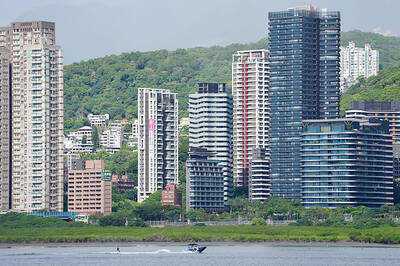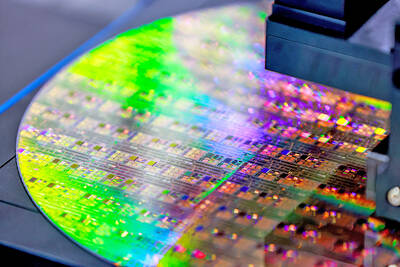The aroma of baking bread wafts through the supermarket, even when the ovens are empty. The breezy scent of coconut oil floats through the bathing suit aisle of the department store when summer is months away.
Welcome to the world of scent marketing. Retailers are increasingly using ambient scents to induce shoppers to stay longer, spend more and maybe even behave a little more kindly toward fellow shoppers.
Beyond just creating a pleasant environment, the nascent scent marketing industry uses fragrance to tap into memory and emotion to strengthen brand identity.

Photo: Reuters
Retailers are wary of discussing it lest they be accused of manipulation, but the fragrance makers, researchers and advertising agents gathered in Miami Beach for the ScentWorld conference this month were happy to explain their art.
“Control is one of the most important parts,” Scentevents founder Neal Harris said. “Too much could be way too much.”
His Los Angeles company provided the cotton candy aroma that sweetened arenas around the world during pop singer Katy Perry’s recent candy-themed “California Dreams” tour. At a Hollywood Halloween party, he did what theme parks are rumored to do by releasing a popcorn aroma to put guests in a snacking mood.
“When you smell popcorn you want to eat it. But they’re not popping the popcorn there,” Harris said.
His company uses fragrance-infused ceramic beads and diffusers to fan the scent through a room. For larger spaces, the scent goes into the air conditioner or ventilating system. It’s a dry system so it doesn’t linger too long.
“You probably don’t want to smell coffee at midnight,” Harris said.
Scent marketing is expanding because the technology has become more sophisticated and more affordable, enabling a small retailer to scent the environment for less than US$100 a month, said Jennifer Dublino, chief operating officer for the five-year-old Scent Marketing Institute.
“Years ago, when this first came out, it was kind of clunky,” she said.
Companies in the industry are privately held and do not report earnings, but Dublino estimates their revenues at US$80 million to US$100 million annually worldwide.
That includes ambient scenting and the use of scents in ink, plastics, rubber and textiles, but not traditional uses of scent, such as consumer packaged goods, food, cosmetics and personal fragrances.
Simon Faure-Field, chief executive of the Equal Strategy consulting firm, has been nicknamed “the smell guy” for his efforts to incorporate scent to build brands.
For a New Balance shoe store in Beijing, he introduced Chinese shoppers to the 105-year-old US brand by creating “a total sensory experience” designed to convey heritage and craftsmanship. He used a nostalgic wood and leather scent, decorated the wooden-floored store with vintage ads and compiled a soundtrack of 1950s bebop music.
Shoppers spent twice as much money as in similarly sized stores elsewhere, partly because the atmosphere induced them to linger, he said.
“The longer a customer stays in a store, the more [they] spend,” Faure-Field said.
Success stories from other companies have inspired others to jump on the bandwagon, Dublino said.
Casinos were early adapters, experimenting with scent as they fought to neutralize cigarette and cigar smoke that chased gamers away. Theme parks use artificial scents to help create the illusion that guests are in ancient castles or forests. Upscale stores scent their baby goods department with the soothing smell of baby powder.
Cruise lines and hotels use signature aromas in their rooms and on the brochures mailed to guests after they go home, in hopes the scent will bring back memories of a pleasant vacation and spur repeat bookings.
Research bears out the powerful influence of smell on behavior, conference speakers said. Shoppers in a mall were more likely to help out a stranger in a pleasantly scented area than when the same area was unscented, said Jean-Charles Chebat, a marketing professor at the HEC Montreal business school.
Aromas stimulate the amygdala, which is also the emotional center of the brain. Once an odor is connected with an emotional experience, it can elicit that emotion later, which can in turn affect behavior, said Rachel Herz, a Brown University professor and expert on the psychology of smell.
However, there is no subliminal odor perception and therefore no way to use stealth scents to make someone buy something. And people’s reactions can vary widely because humans are not hard-wired to like or dislike a particular odor, Herz said.
She cited studies conducted in the middle of the 1960s and in 1978 asking people in the US and the UK to rate the smell of wintergreen from among a battery of common odors.
In the US, where wintergreen was only used in gum and candy, test subjects found it very pleasant. In Britain, where it had not been used in candy, but was widely used in analgesic balms popular during World War II, test subjects hated it and associated it with wartime.
More recently, the US military tried to develop a universal stink bomb to disperse unruly crowds, but could not find an odor that was repugnant to all, not even one dubbed “Army-issue latrine.” That smell was ubiquitous in places without modern plumbing and people who grew up around open-pit latrines were unfazed.
“The degree to which a smell is bad depends on the comfort level with it,” Herz said.
She cited the example of a woman who hated the smell of roses because she first smelled them at her mother’s funeral.
“Once an association with an odor is formed it can stay with you for life,” Herz said.
Retailers and advertisers are trying to tap into that scent association to help establish emotional intimacy with their brands and “get to the kiss quicker,” said Simon Harrop, chief executive of the Brand Sense Agency based in Oxford, England.
The efforts sometimes provoke a backlash. The London Underground coated the platforms at some of its train stations with an encapsulated fragrance, described as a rosy jasmine with a hint of herbs, during a test aimed at making the subway more pleasant in 2001. It was quickly halted when some commuters said that it made them feel sick.
An attempt to promote milk consumption by putting chocolate-chip-cookie scent strips in bus shelters was equally short lived in San Francisco. Transit officials ordered their removal amid concern they might provoke allergic reactions.
Scentmakers point out that many naturally occurring substances can be irritating, as any ragweed sufferer can attest. They say that very few people, generally about 2 percent, suffer allergic reactions to manufactured fragrances and that the industry has worked hard to stop the use of ingredients that can irritate skin or airways.
Complaints are more often based on simple dislike of a fragrance or overuse of scent in a small space, they said.
“One man’s pleasure is another’s pollution,” said Ladd Smith, president of the Research Institute for Fragrance Materials, which analyzes fragrances to determine their safety. “Involuntary exposure drives us crazy.”

Taiwan’s rapidly aging population is fueling a sharp increase in homes occupied solely by elderly people, a trend that is reshaping the nation’s housing market and social fabric, real-estate brokers said yesterday. About 850,000 residences were occupied by elderly people in the first quarter, including 655,000 that housed only one resident, the Ministry of the Interior said. The figures have nearly doubled from a decade earlier, Great Home Realty Co (大家房屋) said, as people aged 65 and older now make up 20.8 percent of the population. “The so-called silver tsunami represents more than just a demographic shift — it could fundamentally redefine the

The US government on Wednesday sanctioned more than two dozen companies in China, Turkey and the United Arab Emirates, including offshoots of a US chip firm, accusing the businesses of providing illicit support to Iran’s military or proxies. The US Department of Commerce included two subsidiaries of US-based chip distributor Arrow Electronics Inc (艾睿電子) on its so-called entity list published on the federal register for facilitating purchases by Iran’s proxies of US tech. Arrow spokesman John Hourigan said that the subsidiaries have been operating in full compliance with US export control regulations and his company is discussing with the US Bureau of

Businesses across the global semiconductor supply chain are bracing themselves for disruptions from an escalating trade war, after China imposed curbs on rare earth mineral exports and the US responded with additional tariffs and restrictions on software sales to the Asian nation. China’s restrictions, the most targeted move yet to limit supplies of rare earth materials, represent the first major attempt by Beijing to exercise long-arm jurisdiction over foreign companies to target the semiconductor industry, threatening to stall the chips powering the artificial intelligence (AI) boom. They prompted US President Donald Trump on Friday to announce that he would impose an additional

Pegatron Corp (和碩), a key assembler of Apple Inc’s iPhones, on Thursday reported a 12.3 percent year-on-year decline in revenue for last quarter to NT$257.86 billion (US$8.44 billion), but it expects revenue to improve in the second half on traditional holiday demand. The fourth quarter is usually the peak season for its communications products, a company official said on condition of anonymity. As Apple released its new iPhone 17 series early last month, sales in the communications segment rose sequentially last month, the official said. Shipments to Apple have been stable and in line with earlier expectations, they said. Pegatron shipped 2.4 million notebook